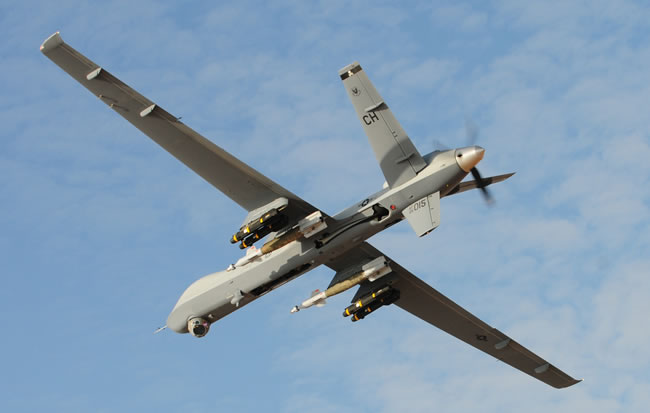

A new version of the General Atomics Aeronautical Systems Inc (GA-ASI) Predator B/MQ-9 Reaper has been flying since May 2012. The new version known as the Block 1-plus, made its first flight on May 24 at the manufacturer’s Gray Butte Flight Operations Facility in Palmdale, Calif., with no discrepancies. GA-ASI has upgraded the Predator B and Block 1 versions of the drone that have been in production since 2003. The MQ-9 Block 1-plus test flight occurred on May 24. With the completion of development, testing, and expected Milestone C decision this fall, follow-on aircraft to the MQ-9 Block 1-plus configuration will be designated “MQ-9 Block 5.”
The MQ-9 Block 1-plus is a capability enhancement over the Block 1 configuration, which has amassed more than 420,000 flight hours across all customers. Block 1-plus was designed for increased electrical power, secure communications, auto land, increased Gross Takeoff Weight (GTOW), weapons growth, and streamlined payload integration capabilities.
Featuring a new high-capacity starter generator, the aircraft offers an increase in electrical power capacity over the current Block 1 design. This increased power provides the aircraft with significant capacity for growth. In addition, the upgraded electrical system includes a backup generator which is sufficient to support all flight critical functions. This vastly improves the reliability of the electrical power system by providing three independent power sources.
New communications capabilities will also be available in the Block 5, including dual ARC-210 VHF/UHF radios with wingtip antennas, allowing for simultaneous communications between multiple air-to-air and air-to-ground parties; secure data links; and an increased data transmission capacity.
Additionally, the new trailing arm main landing gear will be included in Block 5, enabling the aircraft to carry heavier payloads or additional fuel. This “heavy-weight” landing gear increases the aircraft’s landing weight capacity by 30 percent and its gross takeoff weight by approximately 12 percent, from 10,500 lb to 11,700 lb. (from 4,762 to 5,307 kg). The new landing gear will also be available as a field retrofit to operational Predator B systems.
“We continue to enhance the capabilities of our aircraft, improving their performance to meet emerging customer requirements,” said Frank Pace, president, Aircraft Systems Group, GA-ASI. “The first flight of the MQ-9 Block 1-plus follows in the footsteps of the aircraft’s combat-proven Block 1 configuration and is an important technological achievement that will provide increased effectiveness, increased multi-mission flexibility, and even greater reliability.”
“We’ve designed field retrofitable capabilities–lengthened wings, wing-borne fuel pods, and new heavy-weight landing gear–that greatly extend Reaper’s already impressive endurance and range while further increasing its operational flexibility.”
The strengthened landing gear was one of two capability enhancements proposed by GA-ASI in April 2012, following a study the company conducted, exploring potential improvements to the aircraft. Taking advantage of the increased GTOW increase, the Predator B ER (Extended Range) will be able to carry additional payloads, including two external fuel tanks, extending typical Intelligence Surveillance Reconnaissance (ISR) mission endurance from 27 hours to 37 hours. To further increase multi-mission flexibility and capacity, GA-ASI proposed to replace the current 66 ft (20.11 mw) wings with 88 ft wings (26.82 m’), and adding two fuel pods, along with the heavy-weight landing gear, thus increasing mission endurance from 27 hours to 42 hours on ISR-only missions.
Predator B is currently operational with the U.S. Air Force and Royal Air Force as MQ-9 Reaper and the Italian Air Force as MQ-9, with NASA as Ikhana, and with the U.S. Department of Homeland Security as Predator B/Guardian. The aircraft is designed to perform multi-mission ISR and “Hunter-Killer” missions over land or sea, with more than 130 vehicles delivered to date. In August 2012 GA-ASI was awarded $87 million US Air Force contract to upgrade up to 80 Reapers delivered in the past two years.

















